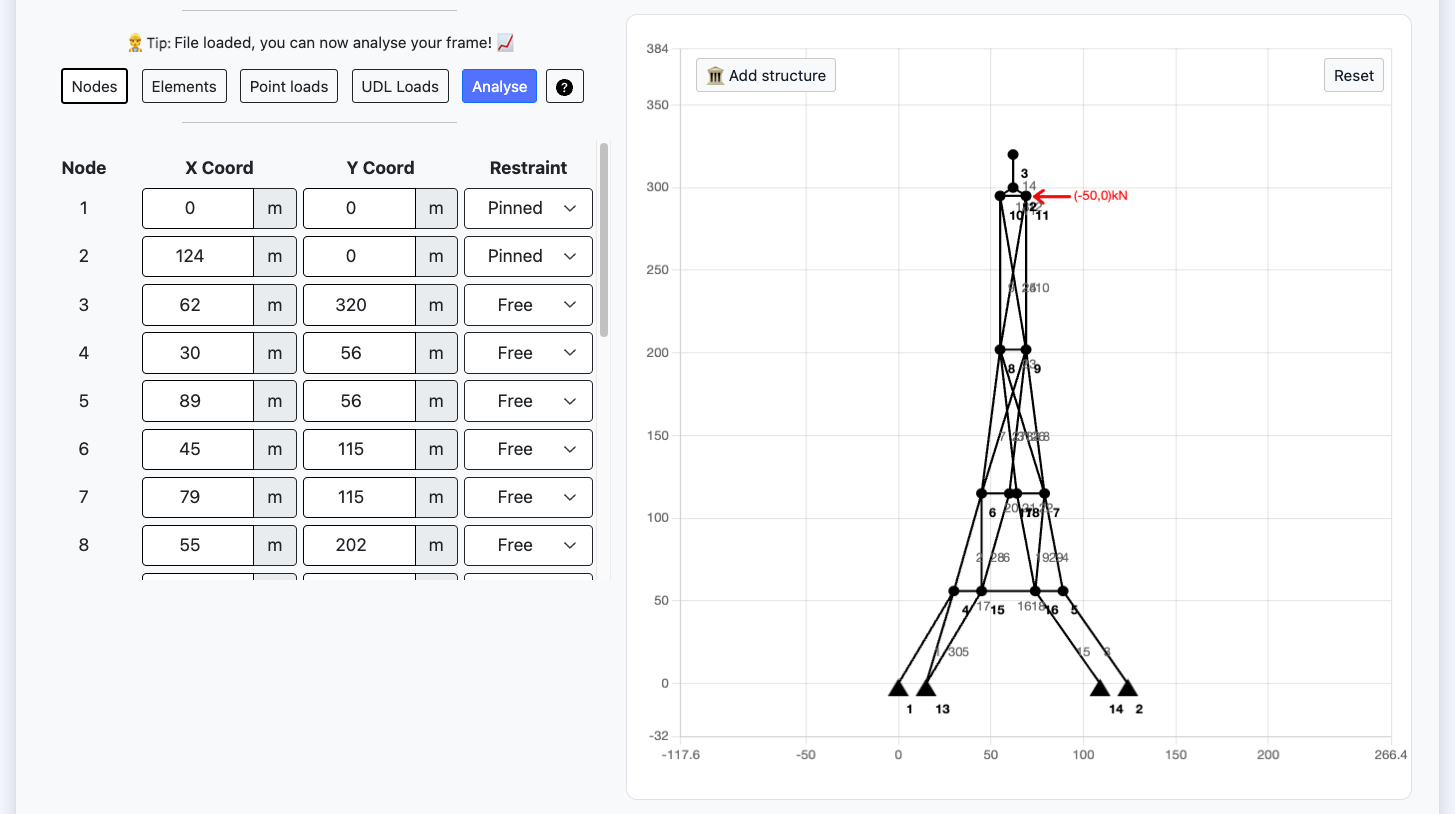Free 3D Structural Finite Element Analysis
Calculate bending moment, shear force, deflection and reactions for a 3D structure.
👷 Tip: Start by adding another node
| ID | X Coord | Y Coord | Z Coord | Restraint |
|---|
| ID | Start node | End node |
|---|
| ID | Node | Load X | Load Y | Load Z |
|---|
| Member | Load X | Load Y | Load Z |
|---|
Update element properties
| Material | A cm2 |
Iy cm4 |
Iz cm4 |
J cm4 |
E GPa |
G GPa |
|---|
| Element | Material |
|---|
Node reaction results
| ID | Fx (KN) |
Mx (KNm) |
Fy (KN) |
My (KNm) |
Fz (KN) |
Mz (KNm) |
|---|
Node displacement results
| ID | Dx | Dy | Dz |
|---|
Element end force results
| ID | Vy,start (KN) |
Vy,end (KN) |
Vz,start (KN) |
Vz,end (KN) |
My,start (KNm) |
My,end (KNm) |
Mz,start (KNm) |
Mz,end (KNm) |
|---|
Element internal force results
| ID | Faxial (KN) |
Vy,max (KN) |
Vy,min (KN) |
Vz,max (KN) |
Vz,min (KN) |
My,max (KNm) |
My,min (KNm) |
Mz,max (KNm) |
Mz,min (KNm) |
|---|
What's this calculator used for?
This free calculator can be used by Structural Engineers for Finite Element Analysis of 3D structures. This tool can be used to calculate bending moment, shear force, node reaction forces and measure deflection for frame structure. Input section properties for beams and columns and apply fixed end, pin jointed and free degrees of freedom to the structure. Add point loads or distributed loads to get started analysing the frame.
Contribute to this code
This code is open source and you can contribute to it's development.
You can find the source code on GitHub here: PyNite
Special credits: JWock82
Interested in learning more about automation?

Enroll on our training certifications and learn how to code, build AI applications with no-code tools and automate tasks.
3D Finite Element Analysis Theory
What is 3D structural analysis?
- Most Engineering problems are 3D problems. To perform 3D structural analysis a frame is broken down into nodes and elements. The corresponding shear forces, bending moments, axial forces and deflections can be calculated using finite element analysis. 3D analysis is frequently on required for detailed design of complex models and often includes some element of dynamic analysis.
What is Finite element analysis?
- Finite element analysis can be used to break down complex shapes into mesh of smaller interconnected elements. The way in which the forces and stresses then distribute throughout the material can be broken down and solved for. Finite element analysis uses partial differential equations describing stress and strain relationships between the elements of the mesh. The calculations performed on each element are polynomial and involve interpolating the values. Determination of values starts at the boundaries of elements, known as nodel points. The calculations then propogate across all the elements in the mesh to arrive at estimated stress and strain values.
How do I run 3D Finite Element Analysis?
- Start by adding the x, y, z coordinates of the nodes of your frame, you may need to zoom out, pan and rotate in order to find the node you are dealing with.
- After adding two or more nodes you can start adding elements, elements connect between nodes and can act in tension or compression to transfer forces between the nodes.
- Now you can begin to add loads to your frame, either apply loads to the nodes or elements of your frame, selecting and checking the correct axis direction on which your forces are being applied. These can be either point loads or distributed loads.
- Check the fixity of your nodes, you can fix nodes in the x, y or z direction, or you can allow them to move freely in all directions.
- Run your analysis to generate results from your finite element analysis software.
- After you've ran your analysis you can inspect your bending moment, shear force, axial and deflection for the different nodes and elements around your structure.
- Finally, you can modify the stiffness of your elements to fine tune your frame analysis to model steel, wood, or any other structural element in the real world.


